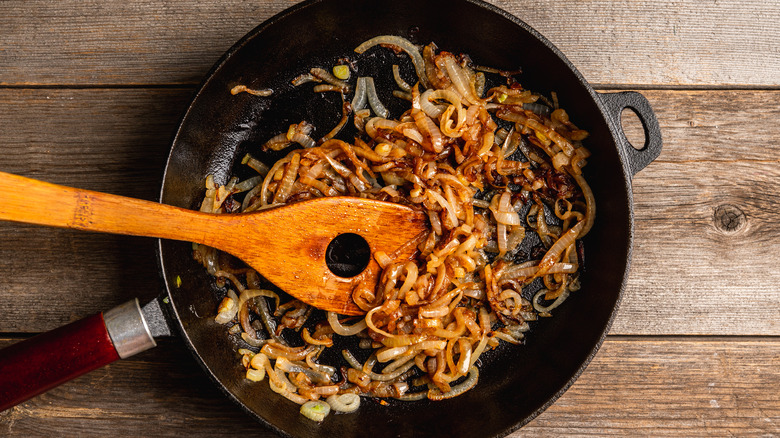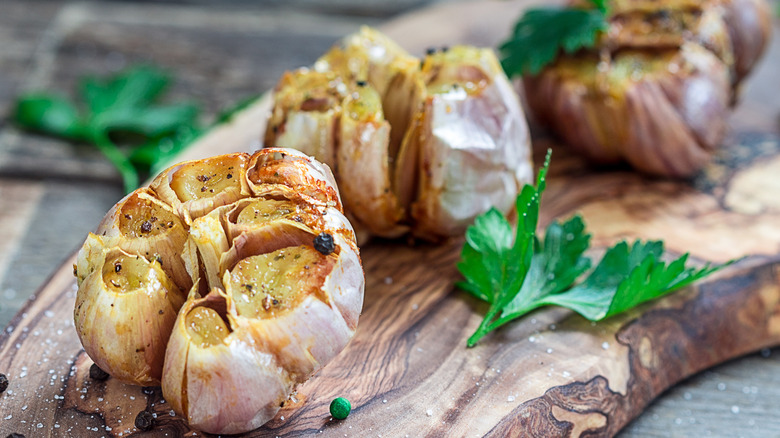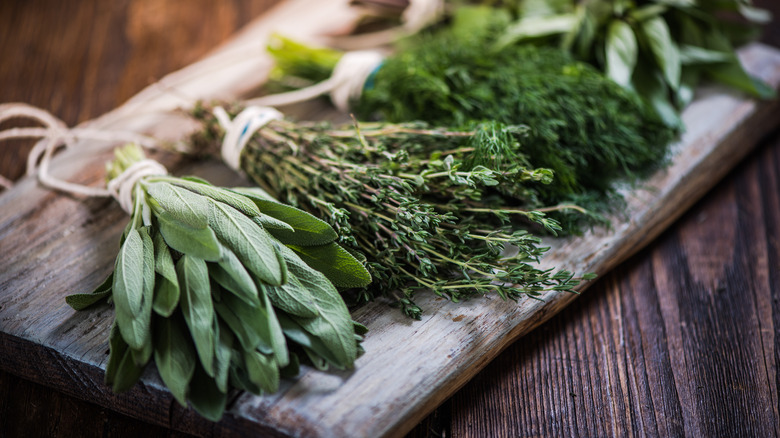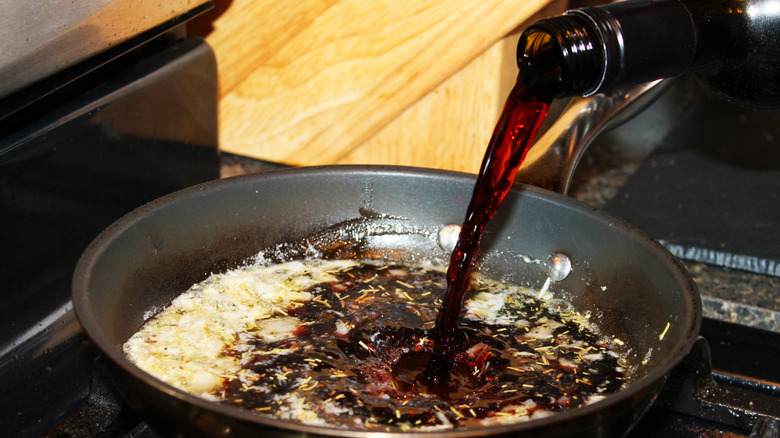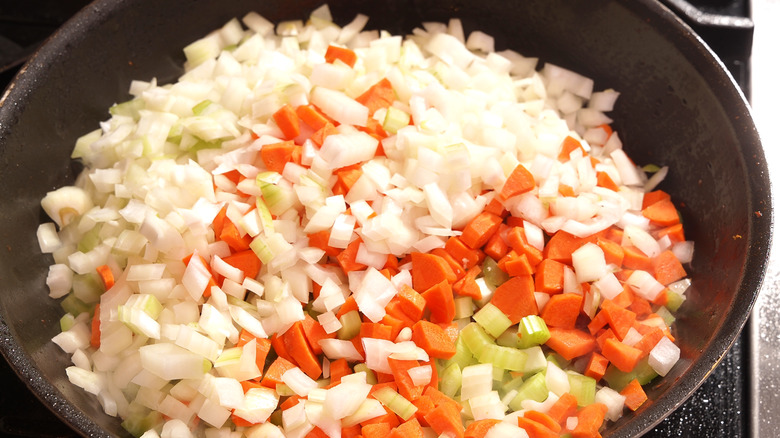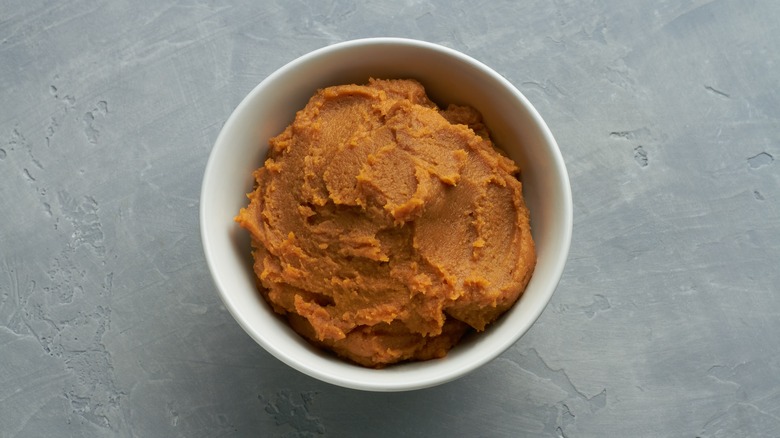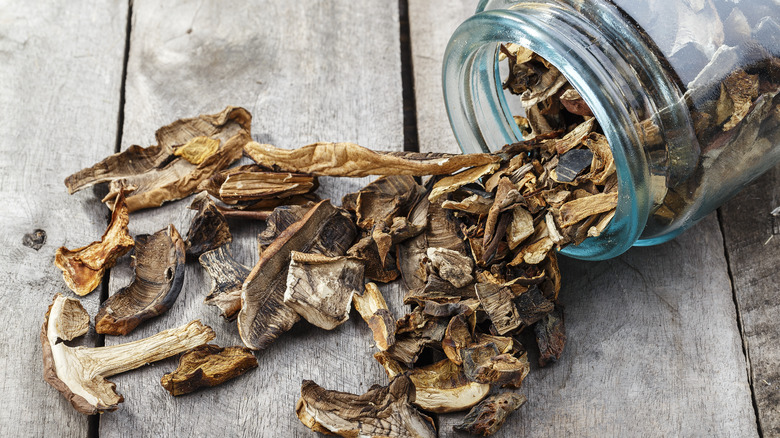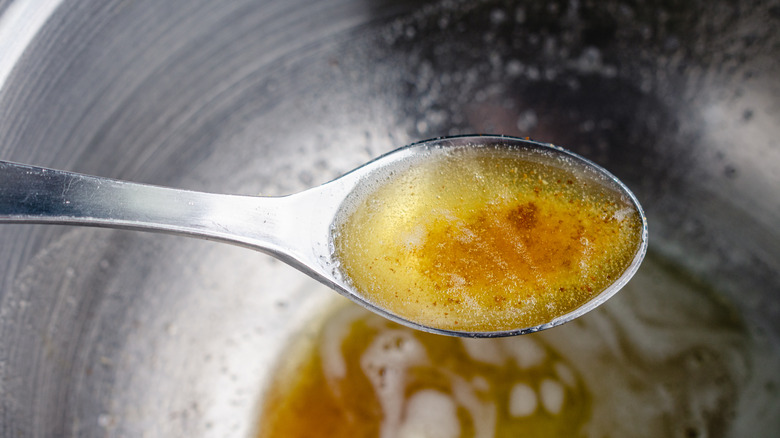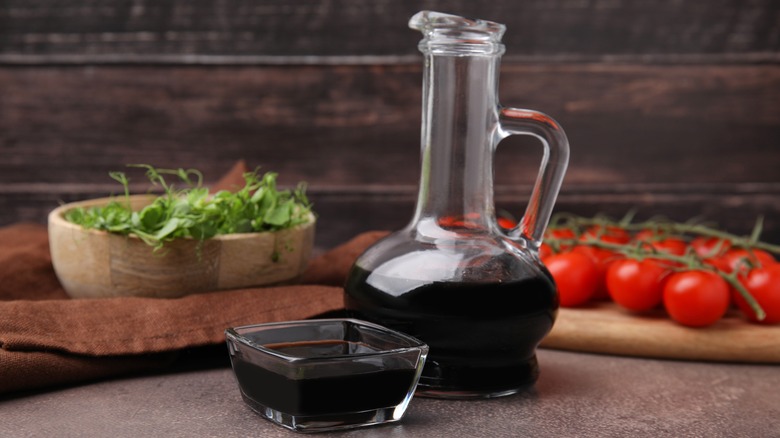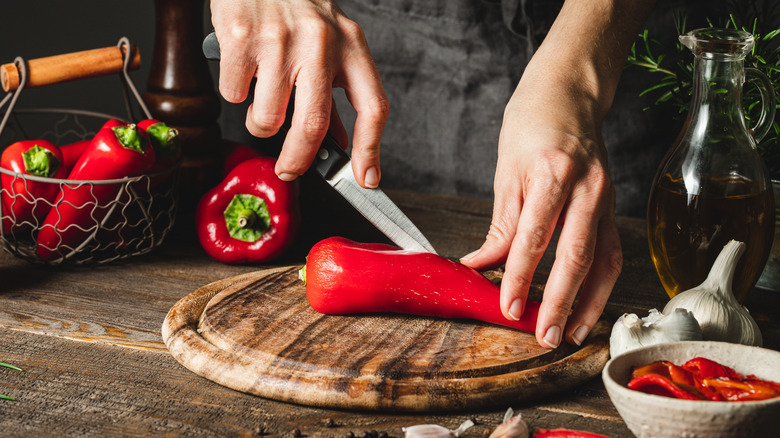12 Ways To Upgrade Instant Gravy
Instant gravy, a pantry staple renowned for its convenience, is a quick and easy way to elevate meals. Crafted from a blend of dehydrated ingredients, this powdered mix transforms into a savory sauce with a simple addition of hot water. While instant gravy saves you time, it isn't anywhere near as tasty as homemade gravy created from scratch. Luckily, there are some excellent ways to upgrade instant gravy to make it tastier without having to go completely DIY on the recipe.
In this article, we explore instant gravy upgrades with techniques people use when making gravy from scratch. You can use some of these same principles to breathe new life into instant gravy while still saving time. This is particularly great for the holidays when you want the tastiest gravy possible but you're already busy enough in the kitchen.
Discover how to infuse depth and richness into your instant gravy, transcending its humble origins. From incorporating aromatic herbs to fortifying with umami ingredients, these techniques draw inspiration from traditional cooking practices. Join us on a culinary journey as we unravel the secrets to transforming this kitchen essential into a savory masterpiece without too much hassle.
1. Caramelize some onions
You might recognize this experience. You're in the kitchen cooking a meal when someone walks in and says, "Wow, that smells amazing." But, all you've done is start to cook some onions. Such is the power of these delicious alliums. So, it's no surprise that adding caramelized onions to instant gravy can boost its flavor impressively.
If you've never caramelized onions before, the good news is it's easy. Begin by thinly slicing onions, choosing varieties like yellow or sweet onions for their higher sugar content. Heat plays a pivotal role in caramelization. A low to medium heat setting allows the onions to gently release their moisture without burning. A combination of oil and butter provides the necessary fats for the chemical reactions that lead to browning and sweetness.
Timing varies, but achieving caramelization often takes at least 30 minutes. The process demands patience and attentiveness, as the onions transition from raw to intensely flavorful. Simply caramelizing onions and then stirring them through your instant gravy not only brings more flavor to the party but also introduces texture and makes the gravy look homemade.
2. Add roasted garlic
Roasted garlic undergoes a remarkable transformation from its raw, pungent state, developing a delicate and buttery flavor profile. The sharpness of raw garlic mellows into a sweet, caramelized essence, and its texture becomes creamy and spreadable. The taste is nuanced, offering a delightful combination of mild sweetness and savory depth, with subtle undertones of nuttiness. Mixing roasted garlic into instant gravy can transform it from basic to bougie.
Roasting garlic is a simple process. Begin by preheating your oven to a moderate temperature (around 350 to 400 degrees Fahrenheit). Cut off the top of a whole garlic bulb to expose the cloves. Drizzle the exposed cloves with olive oil, allowing it to seep into the crevices. Wrap the bulb in aluminum foil to create a sealed packet, then place it in the oven.
Roast the garlic until the cloves become soft and golden brown. This usually takes around 30 to 45 minutes. The slow roasting allows the natural sugars in the garlic to caramelize, resulting in that desirable sweetness. Once roasted, the individual cloves can be easily squeezed out of their skins (leave them to cool for about 10 minutes before attempting this). Then you simply mash them and mix them through your instant gravy.
3. Throw in some fresh herbs
Fresh herbs can enliven instant gravy, making it taste much more complex and nuanced than it does straight out of the packet. With delicate herbs, such as parsley and dill, you can simply chop up and stir through, letting the heat from the gravy wilt them slightly. This helps the flavors of the herbs meld with the gravy. Woody herbs, such as rosemary and thyme, can benefit from being cooked in a pan with the gravy for a few minutes to help them soften and release their flavors.
But what herbs should you use? Some are better suited to a traditional brown gravy, while others work better with the more subtle flavors of white gravy. Dill with its fresh tanginess, chives with their mild onion flavor, and parsley with its mild, grassy, slightly peppery flavor are all great contenders for white gravies. Basil can bring a Mediterranean flair, and cilantro is reminiscent of Indian and Mexican cuisine, bringing something a little different to the table.
Both earthy, floral thyme and woody, piney rosemary are robust enough to shine in a brown gravy. Sage is intensely savory but also bright with floral notes and somehow manages to stand up well in white and brown gravies. You can use any of these herbs individually or experiment with combining them.
4. Use a glug of wine
Introducing wine to instant gravy is a culinary game-changer, offering a quick and effective way to elevate the flavor profile. Whether you're working with brown or white gravy, the addition of wine brings depth, complexity, and a touch of sophistication to the table.
In brown gravy, red wine shines brightest. The robust, fruity notes of red wine complement the savory richness of the brown base, adding layers of flavor. When using red wine in brown gravy, it's advisable to choose a wine that you would enjoy drinking, as the quality of the wine can significantly affect the final taste of the gravy. For white gravy, the choice is white wine, which imparts a more subtle influence. White wine brings a light acidity and a hint of brightness that won't overpower the delicate flavors of the white base. It's essential to select a white wine that aligns with the dish, considering factors such as sweetness and acidity.
To incorporate wine into instant gravy, mix the wine with the instant powder and a little water. Cook the mixture slightly to allow the alcohol to evaporate and the flavors to meld, otherwise the wine might taste raw. Food cooked with wine always tastes fancy — assuming it's done right. So, adding wine to your instant gravy mix is a foolproof way to make it taste as good as homemade.
5. Start with a mirepoix
One way to make a more flavorful take on instant gravy is to start with an aromatic mirepoix. But, let's go back a step. What exactly is a mirepoix? Well, it's a classic combination of aromatic vegetables used as a base in many French dishes. This trio of vegetables consists of onions, carrots, and celery. It serves as a flavor foundation for everything from stocks and soups to sauces and stews — and it can certainly improve your instant gravy.
The traditional ratio for a mirepoix is two parts onions to one part each of carrots and celery. The vegetables are typically diced or coarsely chopped, and the mirepoix is then sautéed or sweated in fat, such as butter or oil, to release its flavors and develop a savory foundation for various dishes. If you want to make a mirepoix to level up your gravy, cook the veggies until they're soft and slightly caramelized. Then mix up your instant gravy as directed, add the mirepoix, and blend them together until smooth. This will add a savory, aromatic layer to your gravy, making it more complex than it would be straight from the packet. It will also thicken it, so you may need to add some more water until the gravy reaches your desired consistency.
6. Add miso paste
Miso paste is a traditional Japanese fermented soybean paste. It's a thick, flavorful paste with a complex taste that can range from sweet and mild to salty and umami-rich, depending on the type of miso and the length of fermentation. Adding miso paste to instant gravy can be a brilliant way to enhance its depth and provide a unique flavor profile.
Miso is renowned for its umami, the fifth basic taste that adds a rich dimension to dishes. Incorporating miso into gravy can elevate its overall flavor, making it more robust and satisfying. It also brings a combination of salty, sweet, and savory notes, contributing layers of complexity to the gravy. This complexity can make the gravy more interesting and enjoyable, even when using instant mixes. Miso's fermentation process imparts a depth and richness that can mimic the slow-cooked, developed flavors found in homemade gravies. This is particularly beneficial when working with instant gravy, which may lack the depth achieved through lengthier cooking processes.
To incorporate miso into instant gravy, dissolve a small amount of miso paste in a bit of warm liquid before adding it to the gravy mix. This helps ensure that the miso disperses evenly, infusing the gravy. The result is a quick and easy way to transform ordinary instant gravy into a more sophisticated, flavorful sauce.
7. Pour in some liquor
We've already discussed wine, but there are other types of alcohol that can bring character and depth of flavor to your instant gravy. Brandy or cognac brings warmth and a holiday feel to gravy. Whiskey, with its bold smoky notes, can also be an excellent choice. It pairs particularly well with darker gravies.
Certain beers, especially darker varieties like stouts and porters, can contribute depth and a malty richness to gravies. Hard cider — particularly dry varieties — creates sweet, fruity notes that take basic gravy to the next level. Vermouth is an aromatized fortified wine. It's available in both sweet and dry varieties and can add herbal and aromatic notes to gravies. Vermouth works well in both brown and white gravies. Other fortified wines, such as port, can also add complex notes that improve simple instant gravy.
When incorporating liquor into your gravy, it's crucial to let the mixture simmer on the stove for a while. This not only allows the alcohol to cook off but also gives the flavors a chance to develop and meld with the other ingredients.
8. Experiment with dried porcinis
Dried porcini mushrooms can be a remarkable addition to instant gravy, elevating the flavor profile with a rich umami depth. This works nicely with both white and brown gravies. If you want to give it a try, first rehydrate the dried porcini mushrooms. Place them in a bowl and cover them with hot water just off the boil. Let them soak for about 20 to 30 minutes. Save the soaking liquid — it's a potent mushroom broth that will enhance the gravy.
After rehydration, finely chop the porcini mushrooms. Sauté them in a pan with a bit of oil or butter until they release their aroma and develop a golden-brown color. This step intensifies the flavor of the mushrooms and adds a savory richness to the gravy.
Next, make up the instant gravy mix but instead of using water, use soaking liquid from the rehydrated porcini mushrooms. This mushroom broth is packed with concentrated flavors and enriches a standard gravy mix. Ensure the mushrooms are evenly distributed throughout the mixture. This integration of mushrooms directly into the gravy infuses it with a robust umami flavor. Allow the gravy to simmer on the stove for some time. This simmering process lets the flavors meld, the mushrooms to further infuse their essence into the sauce, and the overall taste to deepen.
9. Mix in some brown butter
You might have heard of brown butter, but what about brown butter gravy? This nutty, toasty version of butter can add some much-needed complexity to instant gravy. Plus, it only takes a few minutes to brown butter, so it's a simple add-in that can make a big difference.
Still, you might be wondering how exactly you make brown butter. First, get some butter and cut it into evenly sized pieces. This helps the butter melt more evenly. Place the butter pieces in a pan over medium heat. Let them melt completely. The butter will then go through a foaming stage. The water content in the butter will start to evaporate, and you'll see bubbles forming.
As the butter continues to heat, the milk solids will start to brown. Swirl the pan occasionally to ensure even browning. The butter will go from yellow to golden, and finally, to a nutty brown color. Pay close attention during this stage, as the transition from brown to burnt can happen quickly. Brown butter is ready when it emits a nutty aroma. It should have a rich, caramelized scent. Once the desired color and aroma are achieved, immediately remove the pan from the heat and mix it through your instant gravy. Bonus points if you throw in some herbs with the butter while it's browning to add even more flavor to your gravy. Sage makes a particularly tasty addition with brown butter.
10. Use balsamic vinegar
Adding balsamic vinegar to instant gravy can make it taste better, contributing a complex combination of sweetness, acidity, and depth. It brings a sweet, tangy dimension that can balance the richness of the gravy. Its acidity helps cut through the heaviness, providing a more nuanced and well-rounded taste. It also has umami notes that enhance the overall savory profile of the gravy. Plus, the aging process of balsamic vinegar results in a concentrated yet compounded flavor profile. Adding it to instant gravy imparts layers of depth and gives it a gourmet feel.
To incorporate balsamic vinegar into instant gravy, prepare the gravy in a saucepan according to the package instructions. Then add a few tablespoons of balsamic vinegar to the saucepan. Stir the mixture thoroughly to ensure the balsamic vinegar is evenly distributed, and let it simmer on low heat for 3 to 5 minutes. This simmering period gives the flavors a chance to develop. Taste the gravy, and adjust the seasoning if necessary, as the addition of balsamic vinegar may alter the overall balance.
11. Try chilis for heat
If you're looking for a departure from the conventional, infusing brown gravy with chilis or chili powder provides a spicy twist. It transforms this classic gravy into a bold, flavorful, Tex-Mex-inspired sauce. This approach brings the warmth of chilis to the richness of brown gravy, creating a dynamic fusion of tastes.
What do you need to make chili gravy? First, choose your preferred chili variety based on the level of heat you desire. Jalapeños, serranos, or even hotter options like habaneros can be used. Remove the seeds and membranes for milder heat. Or you can opt for a good-quality chili powder blend. This pre-made mix usually combines various ground chili peppers with other spices like cumin, garlic, and oregano.
Finely chop the fresh chilis, and sauté them in a bit of oil or butter before adding them to the gravy. This step helps release the chili flavors and ensures even distribution. Then add them to your made-up instant gravy. Or, for chili powder, stir the desired amount directly into the gravy, adjusting to your preferred level of spiciness. Taste the gravy and adjust the seasoning as needed. Depending on the heat level of your chosen chilis or chili powder, you may want to add a bit more salt or other seasonings to achieve the perfect balance.
12. Stir in some heavy cream
You can transform the standard preparation of instant brown gravy by incorporating heavy cream. The traditional method of making instant brown gravy typically involves using water, but substituting half of the water with heavy cream changes things. Heavy cream contributes a velvety lavishness to the gravy, creating a smoother and more luscious consistency. It also brings its own subtle sweetness and richness, which complements the savory notes of the brown gravy. This combination of flavors results in a more well-rounded and decadent taste profile.
Similarly, if you're working with an instant white gravy mix, substituting heavy cream for water takes the creaminess to an even higher level. This modification transforms the white gravy into a velvety, decadent sauce that pairs exceptionally well with comfort foods like biscuits, poultry, or creamy pasta dishes.
If you replace half the boiling water you're directed to add to your instant gravy mix, you'll need to make up the gravy in a saucepan and let it simmer for a while to make sure it's hot enough. Otherwise, the cream will cool down the gravy, leaving it lukewarm. The cooler temperature also might mean the gravy powder doesn't fully dissolve, leaving you with lumpy gravy.

